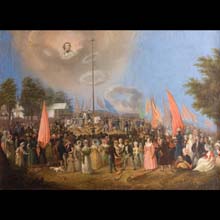
material: oil on canvas
dimensions: 63 x 87,5 cm
description: A decision to commemorate Tadeusz Kościuszko (1746–1817) with a monument worthy of his merits for the country was made soon after the news about the death of the Commander of the uprising of 1794 had been announced. In the summer of 1820, the Governing Senate of the Free City of Krakow adopted a resolution on raising a symbolic tomb for Kościuszko on the Hill of Blessed Bronisława, inspired by two monuments of Polish early history – the mounds of Krakus and Wanda. The picture shows the ceremony inaugurating the building of the mound, which was held on October 16, 1820 and gathered a great many citizens, representing all social classes and the three partitioned territories. In the centre of the composition we can see a spruce marking the axis and the radius of the mound. The painting depicts the moment of blessing the earth from the battlefields of the uprising of 1794. The work is of historical and allegorical nature. It combines the documentary account with figurative and allegorical significance of some elements – the apotheosis of Kościuszko, three circles of smoke from the honorary salute fired by the army symbolizing the Partitions and the idealistic vision of the integrity of the nation. Wacława Milewska
exposition: The Gallery of 19th Century Polish Art in Sukiennice,
The Cloth Hall, 1, Main Market Square
key: Romanticism. Towards national art >>>
dimensions: 63 x 87,5 cm
description: A decision to commemorate Tadeusz Kościuszko (1746–1817) with a monument worthy of his merits for the country was made soon after the news about the death of the Commander of the uprising of 1794 had been announced. In the summer of 1820, the Governing Senate of the Free City of Krakow adopted a resolution on raising a symbolic tomb for Kościuszko on the Hill of Blessed Bronisława, inspired by two monuments of Polish early history – the mounds of Krakus and Wanda. The picture shows the ceremony inaugurating the building of the mound, which was held on October 16, 1820 and gathered a great many citizens, representing all social classes and the three partitioned territories. In the centre of the composition we can see a spruce marking the axis and the radius of the mound. The painting depicts the moment of blessing the earth from the battlefields of the uprising of 1794. The work is of historical and allegorical nature. It combines the documentary account with figurative and allegorical significance of some elements – the apotheosis of Kościuszko, three circles of smoke from the honorary salute fired by the army symbolizing the Partitions and the idealistic vision of the integrity of the nation. Wacława Milewska
exposition: The Gallery of 19th Century Polish Art in Sukiennice,
The Cloth Hall, 1, Main Market Square
key: Romanticism. Towards national art >>>












